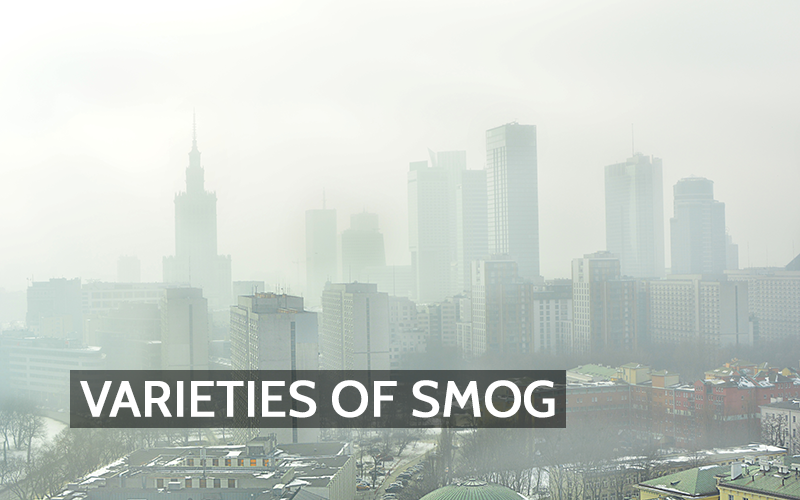Smog has become a pressing environmental issue, impacting air quality and public health worldwide. Understanding the different types of smog, their formation, sources, and consequences is essential to addressing this challenge. This article explores the two primary types of smog—photochemical smog and sulfurous smog—and examines their effects on human health and the environment.
Types of Smog
- Photochemical SmogPhotochemical smog, also known as “summer smog,” forms when sunlight interacts with nitrogen oxides (NOx) and volatile organic compounds (VOCs) in the atmosphere. These chemical reactions produce a mix of pollutants, including ground-level ozone, peroxyacetyl nitrate (PAN), and aldehydes.The formation of photochemical smog typically occurs in urban areas during sunny days when there is a high concentration of vehicle emissions. The ultraviolet (UV) rays from the sun react with chemicals in the air to produce this type of smog.
- Sulfurous SmogSulfurous smog, often called “industrial smog” or “winter smog,” develops when sulfur dioxide (SO2) reacts with moisture in the atmosphere to produce sulfuric acid and other sulfate compounds. This type of smog thrives in cold, damp conditions and is often associated with the burning of fossil fuels like coal and oil.The historical London smog of 1952 is a classic example of sulfurous smog. It formed due to the high use of coal for heating and industry during a period of stagnant atmospheric conditions, causing a severe public health crisis.
Sources of Smog
- Photochemical Smog Sources
- Transportation: Cars, trucks, and buses emit nitrogen oxides and VOCs as a result of fuel combustion.
- Industrial Activities: Factories release VOCs through the use of solvents, paints, and petroleum products.
- Natural Sources: Forest fires and vegetation can also emit VOCs, though their contribution is usually minor compared to anthropogenic sources.
- Sulfurous Smog Sources
- Fossil Fuel Combustion: Power plants, industrial facilities, and residential heating systems release large amounts of sulfur dioxide when burning coal and oil.
- Metal Smelting: This process emits sulfur compounds as a byproduct.
- Volcanic Activity: Natural emissions of sulfur dioxide from volcanoes can contribute to localized sulfurous smog events.
How Smog Impacts Public Health
- Photochemical SmogExposure to photochemical smog can harm respiratory and cardiovascular health. Ground-level ozone, a major component of this smog, irritates the respiratory tract, leading to coughing, throat irritation, and difficulty breathing. Prolonged exposure can worsen asthma, reduce lung function, and increase the risk of respiratory infections.Individuals with pre-existing conditions, such as chronic obstructive pulmonary disease (COPD), are particularly vulnerable. Even healthy individuals, especially children and the elderly, can experience adverse effects during high-smog periods.
- Sulfurous SmogSulfurous smog poses serious health risks, particularly for the respiratory system. Sulfur dioxide and particulate matter can penetrate deep into the lungs, causing inflammation and exacerbating conditions like bronchitis and asthma. In severe cases, exposure can lead to premature death, particularly among the elderly and individuals with heart or lung diseases.The 1952 London smog led to thousands of deaths, highlighting the severe public health impacts of sulfurous smog events.
Smog also Impacts the Environment
- Photochemical SmogPhotochemical smog contributes to environmental degradation in several ways:
- Crop Damage: Ozone, a key component, can reduce crop yields by damaging plant cells and impairing photosynthesis. Sensitive crops, such as soybeans, wheat, and cotton, are particularly at risk.
- Forest Decline: Prolonged exposure to ozone can weaken trees, making them more susceptible to pests and diseases.
- Air Quality Degradation: High levels of ground-level ozone degrade overall air quality, impacting ecosystems and biodiversity.
- Sulfurous SmogThe environmental impacts of sulfurous smog are equally concerning:
- Acid Rain: Sulfur dioxide and other sulfur compounds can lead to acid rain, which harms aquatic ecosystems, corrodes infrastructure, and damages soil health.
- Visibility Reduction: Particulate matter in sulfurous smog reduces visibility, affecting both natural landscapes and urban settings.
- Soil Acidification: Acid rain can alter soil chemistry, reducing its fertility and affecting plant growth.
What are some Key Mitigation Strategies
- Reducing Photochemical Smog
- Emission Controls: Implementing stricter regulations on vehicle emissions and promoting the use of electric and hybrid vehicles can significantly reduce NOx and VOC levels.
- Urban Planning: Expanding green spaces and reducing traffic congestion can help lower smog formation in cities.
- Public Awareness: Educating communities about reducing VOC emissions from everyday activities, such as limiting the use of solvents and paints, can make a difference.
- Tackling Sulfurous Smog
- Transitioning Energy Sources: Shifting from coal and oil to cleaner energy sources like natural gas, wind, and solar can drastically reduce sulfur dioxide emissions.
- Flue Gas Desulfurization: Installing scrubbers in power plants and industrial facilities can capture sulfur dioxide before it enters the atmosphere.
- Legislation: Enforcing air quality standards and monitoring industrial emissions are crucial steps in reducing sulfurous smog.
Understanding the differences between photochemical and sulfurous smog is key to addressing their unique challenges. While photochemical smog predominantly arises from vehicular and industrial emissions during sunny days, sulfurous smog is linked to fossil fuel combustion under cold, damp conditions. Both types of smog pose significant risks to human health and the environment, showing the need for comprehensive mitigation strategies and public awareness. By taking proactive measures, society can improve air quality and safeguard both people and ecosystems from the harmful effects of smog.
Related Article:
Houseplants and Indoor Air Quality: The Reality Behind the Green
References:
- https://education.nationalgeographic.org/resource/smog/
- https://en.wikipedia.org/wiki/Smog
- https://www.epa.gov/transportation-air-pollution-and-climate-change/smog-soot-and-other-air-pollution-transportation
- https://scienceexchange.caltech.edu/topics/sustainability/what-causes-smog
- https://airly.org/en/types-of-air-pollution-types-of-smog/


